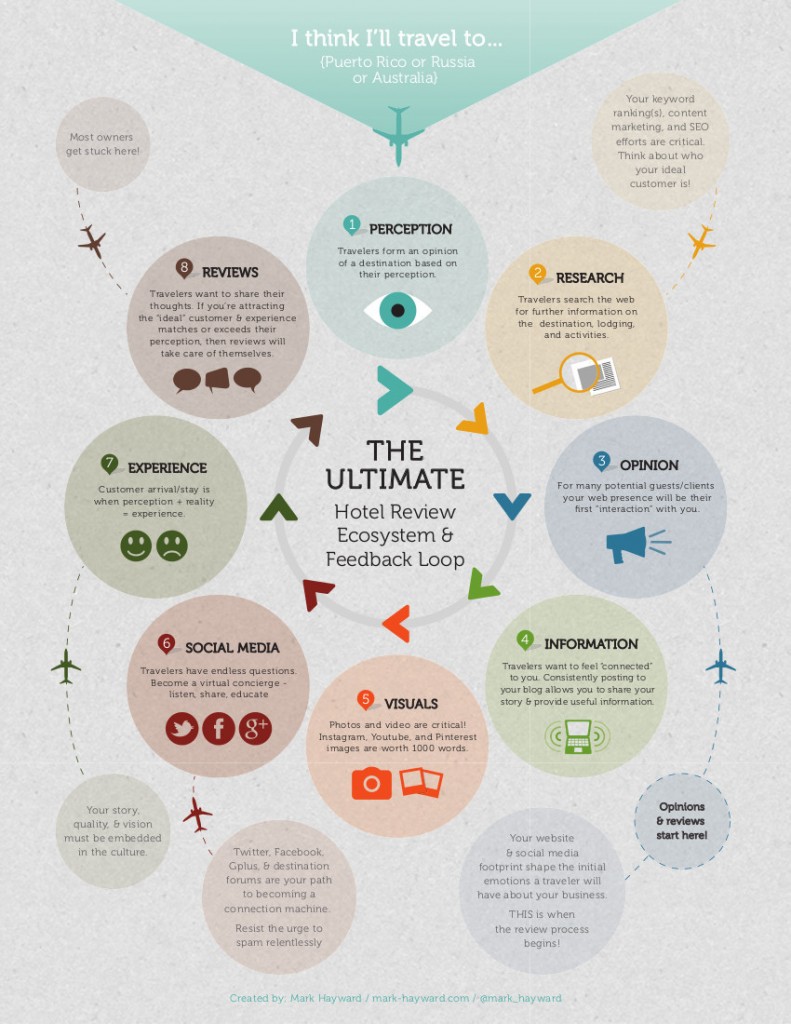Do you own a small to medium sized business? Have you thought about how your customers perceive your business, you, and your staff from what they research online?
Because I used to own a small hotel, I’ve been thinking a bit about customer perception and how it affects what I like to call the “Business Review Feedback Loop.” In fact, I can still vividly recall some travelers showing up to our Inn and having either a huge grin or a complete look of confusion and disappointment.
The initial smile, or dreaded lack thereof, on the new guest’s face was derived mainly from the bits of information they gleaned via their online research — and their emotions came forth when reality met them upon arrival. After talking to many of our guests about this phenomena, it always seemed to come back to their perception — of our destination, the accommodations we were providing, and also of us as the owners.
If you, or any business owners you know are struggling with how this perception — and subsequent online review feedback loop — affects your business, I put this graphic together to shed some insight. (Note: Click graphic to download full size.)
You have the ability to shape your online reputation & web presence!
The graphic above is semi-specific to tourism related businesses, but if your venture is one that many people will find out about online or you regularly get reviewed on YELP or TripAdvisor, then I think it is relevant.
Essentially, potential guests book based on two key factors – perception and trust! In order to maintain a positive customer review feedback loop, there are certain steps that you can take to ensure that you are successful.
1. When a person decides to take a trip or come to your restaurant – from that moment forward they begin to form an idea of what they think the experience will be like. For example, if I told you that you were going to Puerto Rico you might think of wide expanses of empty beaches. If it were Russia perhaps history comes to mind, or Australia maybe conjures up visions of Ayers Rock.
2. After a person has made the decision to travel it’s usually time to research the destination, lodging, and activities on the web — keyword research, content marketing, and overall SEO are critical to attracting your ideal guests/customers.
3. When a potential guest lands on your website their opinion of your property/business – and subsequent review formation – starts here! <<<< Many business owners think the review process starts when a customer leaves their business but in reality it can begin months in advance with their first interaction with your online presence and reputation.
(Note: The next steps in the graphic are meant to help you shape customer perception of your business via your online presence and greater social media activities.)
4. Your business blog is where you can share details of your story and provide useful information as visitors plan their trip. Adding elements of your hotel’s story builds trust, and your generosity with providing travel information and helpful tips further solidifies the establishment of your reputation. Transparency is key!
5. If pictures and video are worth 1000 words, then surely you are well aware that visual media is a critical component to your online presence. YouTube, Flickr, Instagram, and Pinterest are great platforms to focus on.
6. Social channels are your path to becoming a connection machine. Go beyond spammy posts that do nothing but promote your business and use Twitter, Facebook, Gplus, and destination forums to act like a digital concierge. Interacting can help to ensure you are attracting the right types of customers for your business and further serves to assist in building that trust connection before clients even arrive.
7. Customer experience (reality!) begins with arrival. Here’s where the perception you’ve been shaping and the story you have been sharing online is paramount. It doesn’t matter if you offer backpacker or luxury accommodations – the vision of what the customer had in their mind must meet or exceed reality.
8. With respect to reviews and the feedback loop, departure is where many businesses and hotel owners tend to get stuck and focus solely on this interaction. Ideally, however, it would have begun the moment a guest landed on your website, blog, or other online interactions.
Keep your message consistent across all platforms and always remember that perception, reality, and overall experience go into the making of a customer review.

